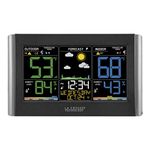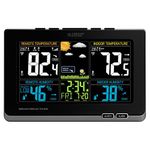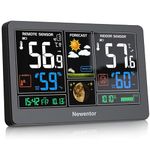10 bestWeather Stationsof December 2025
112M consumers helped this year.
1
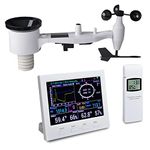
Ecowitt HP3500 Wi-Fi Weather Station, with WS69 Outdoor 7-in-1 Solar Powered Weather Sensor, WN32BP Indoor 3-in-1 Sensor and 4.3'' TFT Color Display Console
ECOWITT

9.8
2

Davis Instruments Wireless Vantage Pro2 Plus with 24-Hr Fan Aspirated Radiation Shield and WeatherLink Console
Davis Instruments

9.6
9% off
3
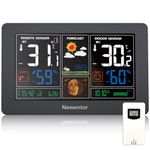
Newentor Weather Station Wireless Indoor Outdoor Thermometer, 7.5in Large Temperature Humidity Monitor, Forecast Station with Barometer, USB Output Port and Adjustable Backlight
Newentor

9.4
4

ECOWITT HP2553 Wi-Fi Weather Station with TFT Large Color Display, WS80 Ultrasonic Anemometer Sensor, WH40 Self-Emptying Rain Gauge Sensor and WN32BP Indoor 3-in-1 Sensor, E-Mail Alert, 915 MHz
ECOWITT

9.2
5
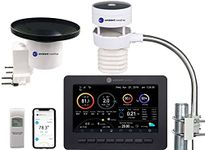
Ambient Weather WS-5000 Ultrasonic Smart Weather Station
Ambient Weather

9.0
Other
6
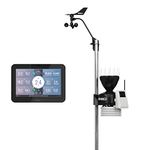
Davis Instruments Wireless Vantage Pro2 with WeatherLink Console
Davis Instruments

8.7
7
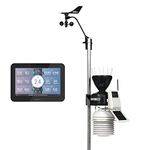
Davis Instruments Wireless Vantage Pro2 with 24-Hour Fan Aspirated Radiation Shield and WeatherLink Console
Davis Instruments

8.4
8

Davis Instruments Vantage Vue Wireless Sensor Suite with WeatherLink Console
Davis Instruments

8.2
20% off
9
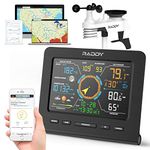
Raddy WF-100C Lite Weather Station 13-in-1 Wireless Indoor Outdoor with Temperature, Barometric, Humidity, Wind Gauge, Rain Gauge, Weather Forecast, Moon Phrase, Alarm Clock for Home, Garden
Raddy

7.9
10
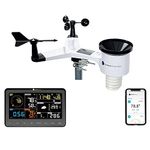
Ambient Weather WS-2902 Smart WiFi Weather Station with Remote Monitoring and Alerts
Ambient Weather

7.6
A Guide to Selecting the Best Weather Stations
Choosing a weather station can be a rewarding experience, especially if you enjoy tracking local weather conditions or need accurate data for gardening, farming, or outdoor activities. The right weather station for you depends on what information you want to collect, how you plan to use it, and where you will install it. Understanding the main features and how they relate to your needs will help you make a smart choice.
Sensor Types
Sensor types refer to the different weather measurements a station can take, such as temperature, humidity, rainfall, wind speed, and barometric pressure. This is important because the more sensors a station has, the more detailed and useful the data will be. Basic models may only measure temperature and humidity, while advanced ones can track wind, rain, UV, and even soil moisture. If you just want to know the temperature and humidity, a simple station will do. If you need more detailed weather tracking for gardening, farming, or scientific purposes, look for a station with a wider range of sensors.
Data Transmission
Data transmission describes how the weather station sends information from the outdoor sensors to the indoor display or your devices. This can be done through cables (wired) or wirelessly. Wireless transmission is more convenient and easier to set up, but the range can vary. Short-range wireless is fine for small homes or apartments, while longer-range is better for larger properties. If you want to access your data remotely, look for stations that connect to Wi-Fi or the internet.
Display and Interface
The display and interface are how you view and interact with your weather data. Some stations have simple screens showing basic information, while others offer color displays, touchscreens, or even app integration for your phone or computer. If you prefer quick, at-a-glance updates, a basic display is enough. If you want to analyze trends or access data from anywhere, look for stations with advanced displays or app support.
Accuracy and Calibration
Accuracy and calibration refer to how close the station's readings are to the actual weather conditions. This is important if you need reliable data for decision-making. Some stations allow you to calibrate the sensors for better accuracy. If you just want general weather information, standard accuracy is fine. If you need precise data for gardening, research, or safety, look for stations known for high accuracy and calibration options.
Power Source
The power source is how the weather station and its sensors are powered. Options include batteries, solar panels, or plugging into an outlet. Battery-powered stations are easy to install anywhere but require regular battery changes. Solar-powered stations are low-maintenance but need good sunlight. Plug-in models are reliable but need to be near a power source. Choose based on where you plan to install the station and how much maintenance you want to do.
Installation and Mounting
Installation and mounting refer to how and where you set up the sensors. Some stations are designed for easy setup on a window or wall, while others need to be mounted on poles or rooftops for best results. If you want a quick and simple setup, look for models with easy mounting options. If you want the most accurate readings, be prepared to install the sensors in open, unobstructed areas, which may require more effort.
Data Logging and Storage
Data logging and storage means the station can save weather data over time, allowing you to track trends and patterns. Some stations only show current conditions, while others store days, weeks, or even months of data. If you just want to know the current weather, this feature is less important. If you want to analyze weather trends or keep records, look for stations with good data logging and easy ways to export or view the data.
Best Reviews Guide Newsletter
Get exclusive articles, recommendations, shopping tips, and sales alerts
Sign up for our newsletter to receive weekly recommendations about seasonal and trendy products
Thank you for subscribing!
By submitting your email address you agree to our Terms and Conditions and Privacy Policy

